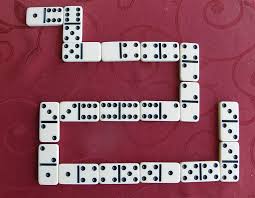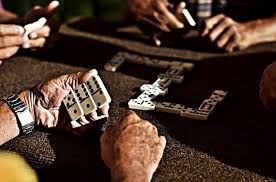 EL JUEGO DE DOMINO, UN SAGRADO PASATIEMPO DE LOS CUBANOS.
EL JUEGO DE DOMINO, UN SAGRADO PASATIEMPO DE LOS CUBANOS.
La popular enciclopedia electrónica Encarta, para ejemplificar las costumbres de los cubanos –de dentro y de fuera de la Isla– sitúa las imágenes de dos mesas de dominó con sus respectivos jugadores y mirones –sapos en el argot–, una en Cuba y la otra en la Pequeña Habana de Miami. Acaso de tantas costumbres que se han ido perdiendo, la de jugar dominó es una de las poquísimas que sobrevive en el siglo XXI. Una fiesta familiar, o una reunión de amigos y amigas siempre puede conducir a una mesa de dominó.
Como todo el mundo sabe el dominó en Cuba es sagrado y se juega en cada rincón, desde la punta de Maisí hasta el cabo de San Antonio. En la isla el dicho sería: “no hay sábado sin sol, ni fiesta cubana sin dominó”.
El dominó es un juego de mesa en el que se emplean unas fichas rectangulares divididas en dos cuadrados, cada uno de los cuales lleva marcados de cero a nueve puntos.
El origen del juego tiene varias versiones.
La primera se basa en la supuesta más antigua alusión escrita sobre el dominó, la cual se localiza en China, en el escrito “Antiguos hechos de Wulin”. En dicho documento se hace referencia a los “pupai” (juegos de placas o dominós) y a los dados como objetos vendidos por los mercaderes durante la dinastía Yuan.
Otras versiones explican que el nombre del juego es de origen francés y fue tomado de una capucha negra por fuera y blanca por dentro, los mismos colores que presenta el dominó generalmente. Supuestamente los italianos fueron los que lo regaron por toda Europa.
El caso es que llegó a Cuba y no se sabe con exactitud si vino desde Italia, España o Estados Unidos.
En la isla existen dos tipos de dominós: el oriental que emplea 28 fichas, con combinaciones del 1 al 6. Y el que se juega en occidente que tiene 55 fichas, que llega hasta el 9. Generalmente se juega en pareja aunque también existen otras modalidades como el “solo para solo”, la longaniza, etc.
El dominó en nuestro país no es solo poner una ficha tras otra, con el objetivo de pegarse. La experiencia del juego va más allá. Se trata de todo un vocabulario exclusivo para el mismo, de actitudes y estrategias como farolear, agacharse, botar la gorda, tirar las fichas, tocar la mesa para pasarse, etc.
Por ser el juego de mesa más popular, el dominó comparte con el béisbol el privilegio de hacer la mayor cantidad de aportaciones a la fraseología. Continuamente, en diversas situaciones, se utilizan frases que son metáforas de este juego, tales como “dale agua al dominó” (para que algo se mueva, que fluya); “se trancó el juego” (cuando una situación no tiene salida); “refresca la data” (alivia la tensión); “la misma y la parecida” (la situación no cambia).
Un lector no cubano probablemente no entiende de qué se trata, tiene que verlo y vivirlo. De seguro va a disfrutar la pasión que ponemos en cada ficha.
 THE DOMINO GAME, A SACRED HOBBY OF THE CUBANS.
THE DOMINO GAME, A SACRED HOBBY OF THE CUBANS.
The popular Encarta electronic encyclopedia, to exemplify the customs of Cubans – inside and outside the island – places the images of two tables of dominoes with their respective players and bystanders -sapos in the slang-, one in Cuba and the other in the Little Havana of Miami. Perhaps of so many customs that have been lost, the one to play dominated is one of the very few that survives in the 21st century. A family party or a gathering of friends can always lead to a domino table.
As everyone knows, dominoes in Cuba are sacred and are played in every corner, from the tip of Maisí to Cabo de San Antonio. On the island the saying would be: “there is no Saturday without sun, no Cuban party without dominoes”.
Dominoes are a board game in which rectangular tiles are used divided into two squares, each of which is marked from zero to nine points.
The origin of the game has several versions.
The first one is based on the supposed oldest allusion written on the domino, which is located in China, in the writing “Ancient facts of Wulin”. In this document, reference is made to the “pupai” (games of plates or dominoes) and dice as objects sold by merchants during the Yuan dynasty.
Other versions explain that the name of the game is of French origin and was taken from a black hood on the outside and white on the inside, the same colors that the domino usually presents. Supposedly the Italians were the ones who watered it all over Europe.
The fact is that he arrived in Cuba and it is not known exactly if he came from Italy, Spain or the United States.
There are two types of dominoes on the island: the oriental one that uses 28 tiles, with combinations of 1 to 6. And the one played in the West that has 55 tiles, which goes up to 9. Usually, it is played as a couple although there are also other modalities such as “only for solo”, longaniza, etc.
The domino in our country is not just put one chip after another, with the aim of sticking. The experience of the game goes further. It is a whole vocabulary exclusive to it, attitudes and strategies such as bluffing, bending, throwing fat, throw the chips, touch the table to pass, etc.
As the most popular board game, dominoes share with baseball the privilege of making the most contributions to the phraseology. Continuously, in various situations, phrases that are metaphors of this game are used, such as “give water to the domino” (so that something moves, that flows); “The game went dead” (when a situation has no exit); “Refresh the data” (relieves tension); “The same and the similar” (the situation does not change).
A non-Cuban reader probably does not understand what it is, has to see it and live it. You will surely enjoy the passion we put in each card.
Agencies/ TeAmoCuba/ Yuli Rodríguez/ Extractos/ Excerpts/ TodaCuba/ Internet Photos/ Arnoldo Varona/ www.TheCubanHistory.com
THE CUBAN HISTORY, HOLLYWOOD.



 < THE DOMINO GAME, a Sacred Hobby of the Cubans.
< THE DOMINO GAME, a Sacred Hobby of the Cubans.





